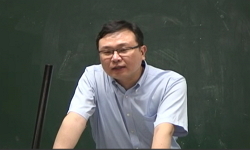A Study on Chinese Translation of Korean Modern Poetry-Based on the Translation of Yu Jahyo’s Chu SeokSuyin Li Abstract: This paper discussed about Chinese translation of Korean modern poetry. The research is based on the different translation vers...
http://chineseinput.net/에서 pinyin(병음)방식으로 중국어를 변환할 수 있습니다.
변환된 중국어를 복사하여 사용하시면 됩니다.
- 中文 을 입력하시려면 zhongwen을 입력하시고 space를누르시면됩니다.
- 北京 을 입력하시려면 beijing을 입력하시고 space를 누르시면 됩니다.

한국 현대시의 중국어 번역에 대한 고찰-유자효 <추석>의 중국어 번역문을 중심으로 = A Study on Chinese Translation of Korean Modern Poetry -Based on the Translation of Yu Jahyo’s Chu Seok
한글로보기부가정보
다국어 초록 (Multilingual Abstract)
A Study on Chinese Translation of Korean Modern Poetry-Based on the Translation of Yu Jahyo’s Chu SeokSuyin Li
Abstract: This paper discussed about Chinese translation of Korean modern poetry. The research is based on the different translation versions of a Korean modern poem Chu Seok written by Yu Jahyo. Translation methods are reviewed and compared by three aspects including paradigmatic and syntagmatic relation, rhetoric and translation into ancient Chinese poetry. We found that translators always select words from semantic fields in which words are in paradigmatic relationship. Translators always use many literary expressions, which could be explained by the defamiliarization theory. We also paid attention to the rhetorics and found that to make better translations, translators used extra rhetorics which are not used in the original text including metaphor, repetition and “nianlian”. Some translators translated the modern poetry into ancient Chinese poetry’s form. It could make the translations have a rhythm and be more compact and could satisfy the readers who prefer the ancient poetry's form. But some translations are not faithful to the original text and some translators might not have enough language ability of ancient Chinese, which could be a problem.
Key Words: Korean Modern Poetry, Chinese Translation, Paradigmatic and Syntagmatic Relation, Rhetoric, Translation into Ancient Poetry’s Form
국문 초록 (Abstract)
한국 현대시의 중국어 번역에 대한 고찰-유자효 <추석>의 중국어 번역문을 중심으로이 수 인* 연구 목적: 이 연구는 한국 현대시의 중국어 번역에 대해 고찰하는 데 목적을 두고 있다. ...
한국 현대시의 중국어 번역에 대한 고찰-유자효 <추석>의 중국어 번역문을 중심으로이 수 인*
연구 목적: 이 연구는 한국 현대시의 중국어 번역에 대해 고찰하는 데 목적을 두고 있다.
연구 방법: 유자효의 <추석> 번역문을 대상으로 비교 연구법을 통해 한국 현대시의 중국어 번역 방법을 고찰하였다.
연구 내용: 구체적으로 통합관계 및 계열관계의 시각, 수사학의 시각 및 중국 고시(古詩) 형식으로의 번역 등 세 가지의 측면에서 검토하였다.
결론 및 제언: 검토한 결과 단어를 번역할 때 번역자가 항상 서로 계열관계를 이루는 의미장에서 단어를 선택해야 한다. 번역자들은 대량의 문어체 표현을 선택했으며 이는 “낯설게 하기” 이론으로 설명할 수 있다. 또한 효과적이고 미적인 번역문을 만들기 위해 번역자들은 원문에 없는 비유, 반복, 염연(拈連) 등의 수사법도 능동적으로 활용하였다. 한국 현대시를 중국 고시(古詩)의 형식으로 번역할 때 시의 리듬과 운율을 살릴 수 있고 특정한 독자층을 만족시킬 수 있으며 보다 세련되고 함축적인 번역문을 만들 수 있다. 하지만 원문에 충실하지 않거나 고대 중국어 소양 부족으로 인한 번역 실수를 주의해야 한다.
핵심어: 한국 현대시, 중국어 번역, 통합 관계 및 계열 관계, 수사학, 고시(古詩) 형식으로의 번역
□ 접수일: 2022년 11월 10일, 수정일: 2022년 11월 28일, 게재확정일: 2022년 12월 20일* 북경외국어대학교 한국어번역학과 박사과정(Doctoral Course, Beijing Foreign Studies Univ., Email: 1005329511@qq.com)
동일학술지(권/호) 다른 논문
-
- 인문사회 21
- 송미승
- 2022
- KCI등재
-
노동조합 관련 인식이 복지국가 지지에 미치는 영향 연구
- 인문사회 21
- 강상준
- 2022
- KCI등재
-
온라인 여행 폴랫폼이 사용자의 구매의사에 미치는 영향기제에 관한 연구
- 인문사회 21
- 가몽함
- 2022
- KCI등재
-
모래놀이치료에서 나타난 뇌성마비 아동의 비언어적 의사소통
- 인문사회 21
- 곽수경
- 2022
- KCI등재





 KCI
KCI KISS
KISS






